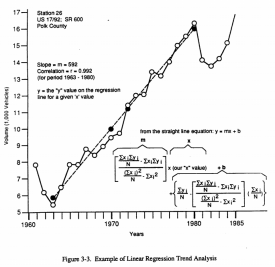Editor’s Note: Read the follow-up post here.
Looking through an old WSDOT traffic forecasting manual from 1991, Sightline intern Alex Broner came across this gem, illustrating the standard practices of the traffic engineering profession 20 years ago:
To calculate [traffic] growth, a simple linear regression technique is used to fit a straight line through historical traffic volumes on roads containing projects that do not add lanes. A straight line has proven to be the best fit for predicting future volumes for areas not subject to significant changes in population or employment growth. To confirm that linear growth should be used, the data are plotted on graph paper and examined for evidence of linear stability. A straight line is then fitted to the stable portion of the graph, and the slope is determined. [See pages 31-33.]
The chart to the right, taken from p. 32 of that report, illustrates the technique. (If you’re a traffic-math nerd, feel free to click to see a larger, more detailed image.)
Stripping away all of the math-speak, the meaning of the passage is clear: traffic volumes always grow. Even in places where population and job counts are stable, traffic volumes still grow. So the safest way to predict the future is to cherry-pick a reasonably stable period of growth in the recent past, and simply assume that traffic will continue to grow that fast in the future.
As simplistic as this technique seems now, it probably worked just fine for decades! Back when gas was cheap, median incomes were rising, and the baby boomers were moving towards their peak driving years, traffic volumes really did increase steadily. The only interruptions were temporary: the occasional recession or oil price spike.
Today’s traffic models are more sophisticated than the ones used 1991 (although some folks have continued to use the old forecasting methods, with occasionally laughable results). Still, the engineers who created the new models were steeped in the old mindset: traffic volumes always grow, so the only choices are more roads or more gridlock. Over the last decade, though, the reality has been much different: due to a combination of rising gas prices, economic jitters, evolving demographics, and changing habits, overall traffic has been fairly flat since the early 2000s.
And that’s how we wind up with traffic forecasts that are completely at odds with the reality of the last decade. Forecasts of ever-increasing traffic used to be standard practice. But now, as many of today’s engineers are figuring out, the future doesn’t always look like a straight-line projection from the past.










Ann
Thanks, Clark. For years I thought we should be looking backwards, not to project traffic growth into the future, but to see what decisions were made in the past that contributed to where we are now. We could then use that information to make decisions about where we want to be in the future. Clearly responding to growth in traffic by simply building more lanes on highways wasn’t getting us out of the transportation mess we’ve gotten ourselves into.
Of course, the traffic engineers shrug off such policy discussion by saying they don’t cause traffic; they are just responding to demands created by land use, which is a local government decision. And so the cycle continues.
I appreciate that you are at least trying to find alternative ways to look at this problem.
Clark Williams-Derry
That’s a brilliant way of looking at things, Ann. The traffic engineering profession still seems stuck in the “predict and provide” mentality — that is, predict the future, and provide the infrastructure that will be needed to support the future that will inevitably arrive. The profession as a whole doesn’t seem to realize that they’re creating the future, rather than simply predicting it.